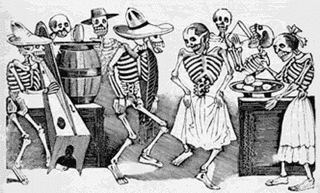
Before I start this series of posts, I would like to state that this is not meant to be a comprehensive guide on the subject. It is only a primer for those individuals who may for one god- forsaken reason or another find themselves in West Texas and do not wish to commit any social blunder concerning the cuisine of this area and for those residents who have forsaken their culinary roots and now wish to re-enter the fold. I am sure that certain omissions or vaguaries of terminology will occur so all suggestions for possible amendments, additions, or editing will be given due consideration. With that out of the way, I bring you:
Lesson 1 - Basic Food Groups1) Fruits and Vegatables:As far as vegatables are concerned, you cannot go wrong with the three staples; beans, 'taters, and corn on the cob. Other acceptable vegatables are okry, squarsh, jalepeno peppers, onions and home grown tomaters. As the old song tells us, 'There is only two things that money can't buy and that's true love and homegrown tomaters.' All other vegatables are suspect as you are essentially stealing the food source of real people food which is meat. If you are in a West Texas restaurant and are given the choice between salad or soup always choose the chili. This is important as it could affect the swiftness of the waitstaff when bringing beer refills.
Most all fruits are acceptable provided that they are cooked in an acceptable fashion, which is either baked in a pie, cake, or cobbler or if they are sliced up and swimming in Cool Whip.
2) Dairy Products: Dairy products consist of:
Milk which is essential for breakfast flakes.
Butter for slathering on toast or cooking items which don't produce enough essential grease on their own.
Cheese for burgers or hell everything is better with cheese and remember cheese in a can is not only handy but is nutritional gold in a can.
Eggs which along with salsa and enchilada's is a key tool in fighting hangovers.
Cool Whip and remember although Reddi-Whip is handy for sexual purposes has almost no nutriative value due to the laughing gas which releases the Reddi-Whip. Although that has uses of which I will not discuss here.
Ice Cream which is essential for a decent cobbler.
3) Grains and Cereals:This is an important part of the healthy diet of any West Texan as it is the essential ingrediant behind breakfast cereal, white bread, tortillas, and approved desserts such as cakes, pies, and cobblers.
4) Meat:Now this is real food and includes any animal flesh that can be killed, caught, fished, or scooped off the side of the road after being runned over before it gets to ripe. From armadillos to zebras, all creatures can be made edible and even tasty if cooked using time tested methods. More on these methods in Lesson Three.
5) Gravies and Greases:In West Texas, it is known that food is better when something is added to help make it slide down better for digestion and to enhance the taste. It is so important that it is a food group in and of itself, eventhough its ingredients are derived from the other food groups.
Gravies: The three main vareities of gravies includes cream gravy, brown gravy, and Tex-Mex gravy. In a future post, the uses of these gravies will be dealt with in greater detail.
Greases: It would be impossible to overstate the importance of good grease in preparing West Texas Cooking. Although lard has lost favor, it is still used by some but most of it's uses have been replaced by vegatable shortening and oil. In times past all kitchens had three coffee cans for catching the three main greases. These three greases are bacon grease, chicken grease, and fish grease and woe to the child, when it was their turn to clean up the kitchen and they poured a skillet of grease into the wrong can.
This concludes the first edit of West Texas Nutrition Lesson One and the next will cover condiments, drinks, sauces, and dips. My thanks to everyone who has contributed their suggestions and shown interest in the subject.













































